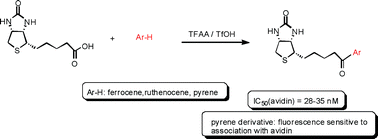Biotin as acylating agent in the Friedel–Crafts reaction. Avidin affinity of biotinyl derivatives of ferrocene, ruthenocene and pyrene and fluorescence properties of 1-biotinylpyrene
Abstract
(D)-Biotin was used for Friedel–Crafts

* Corresponding authors
a
Department of Organic Chemistry, University of Łódź, 91-403 Łódź, Tamka 12, Poland
E-mail:
janzak@uni.lodz.pl
b
Chimie Paristech (Ecole Nationale Supérieure de Chimie de Paris), Laboratoire Charles Friedel, CNRS UMR 7223, 11 rue Pierre et Marie Curie, Paris cedex 05, France
E-mail:
michele-salmain@chimie-paristech.fr
(D)-Biotin was used for Friedel–Crafts

 Please wait while we load your content...
Something went wrong. Try again?
Please wait while we load your content...
Something went wrong. Try again?
D. Plażuk, J. Zakrzewski and M. Salmain, Org. Biomol. Chem., 2011, 9, 408 DOI: 10.1039/C0OB00319K
To request permission to reproduce material from this article, please go to the Copyright Clearance Center request page.
If you are an author contributing to an RSC publication, you do not need to request permission provided correct acknowledgement is given.
If you are the author of this article, you do not need to request permission to reproduce figures and diagrams provided correct acknowledgement is given. If you want to reproduce the whole article in a third-party publication (excluding your thesis/dissertation for which permission is not required) please go to the Copyright Clearance Center request page.
Read more about how to correctly acknowledge RSC content.
 Fetching data from CrossRef.
Fetching data from CrossRef.
This may take some time to load.
Loading related content
